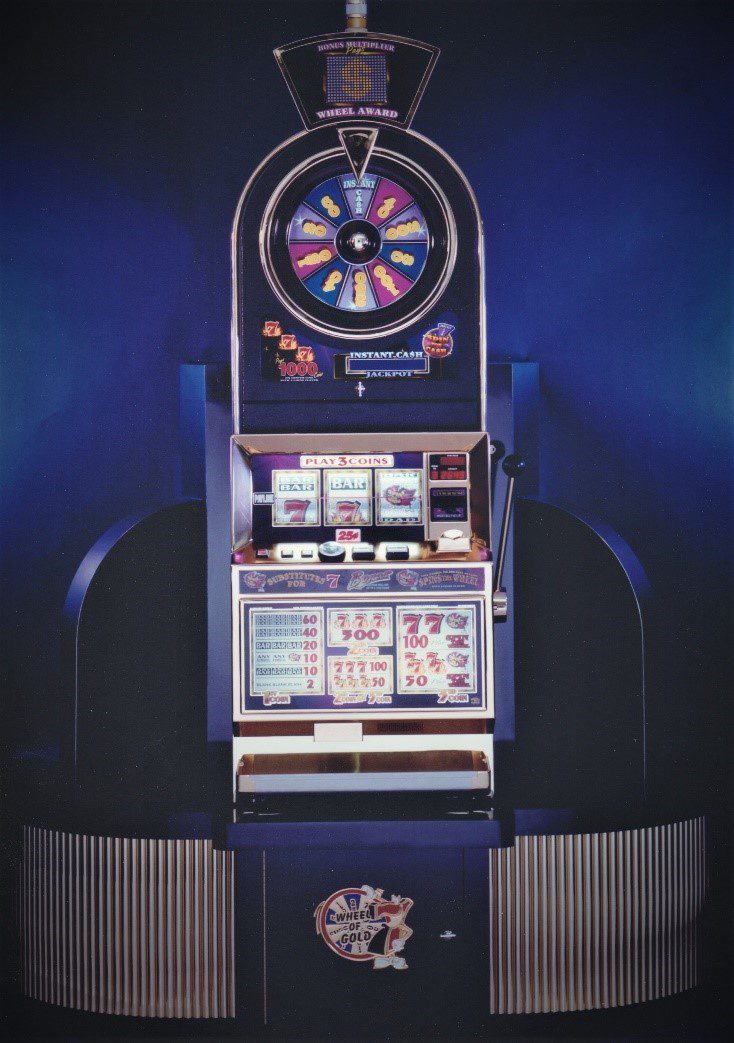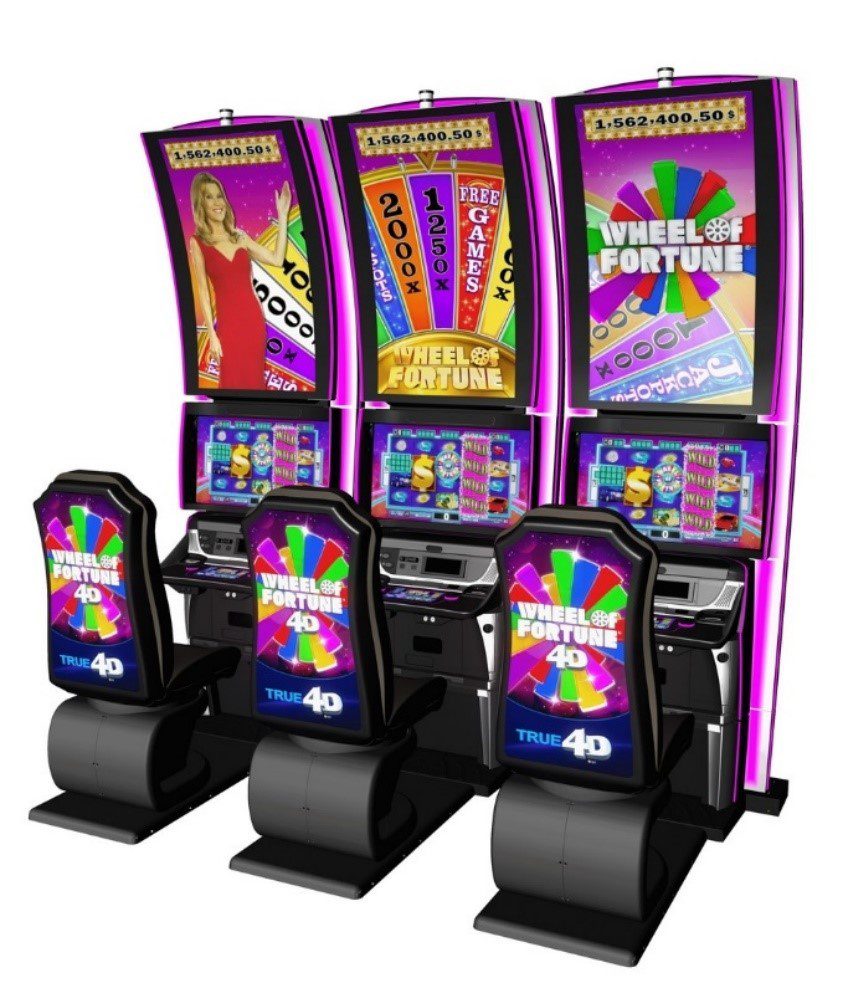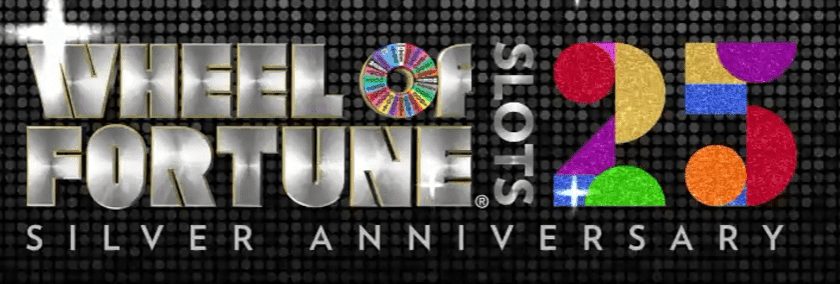
We can have some lively discussions about whether QB Tom Brady or someone else is football’s Greatest Of All Time. The same goes for basketball, golf, baseball and hockey, where there’s a healthy lineup of candidates to spark the debate. But when it comes to slot machines, there’s little argument that the GOAT is IGT’s “Wheel of Fortune.” For a quarter of a century WOF has been a consistent Number One in earnings. While the game has dipped slightly in the last few years, it never has dropped out of the Top Three. No other machine is even close.
In conjunction with a Silver Anniversary celebration, IGT began a “25 Weeks of Wheel of Fortune Slots” promotion in June featuring giveaways, trivia, contests and collectibles. Their promotional materials cite these impressive stats: the game has minted more than 1,100 millionaires; awarded $3.3B (that’s a “B” for billions) in jackpots; spawned 250 versions; and set a brand record in 2009 with a $14.4 million payout to a single player in Biloxi, MS.
In the latest June 2021 Eilers-Fantini Game Performance report, Wheel of Fortune has 10 of the Top 25 games in the Wide Area Progressive category.
Ever wonder why it was so successful? You’re not alone. The entire industry worked for years to replicate its magic formula. Was it the brand? The wheel? The sound? The WAP jackpot? The size? IGT’s team? Or the math? The answer to all those questions is “Yes.” It was simply the best combination of good ideas at exactly the right time, the right place, and led by the right group of innovators.

Chuck Woolery, the first host of Wheel of Fortune
Let’s begin with the brand. The Wheel of Fortune television series first aired in 1975 as a daytime game show. It was the creation of former big-band singer and television personality, Merv Griffin. The WOF show, along with his companion Jeopardy show, made him one of television’s richest moguls. WOF, now owned by Sony Pictures Television Inc., is the longest-running and most successful syndicated TV game show in U.S. history. And that doesn’t even count the 60+ international versions.
Everyone knows the famous hosts: Chuck Woolery and Susan Stafford (wait, what?!?). Yes, they were the first WOF couple, with Pat Sajak replacing Woolery in 1981, and Vanna White stepping in for Stafford in ’82.
That’s when the magic really began. Pat & Vanna are now American icons, dominating pre-primetime living rooms for 30 years. Sajak has now claimed the record for the longest-running host of any TV game show, surpassing The Price is Right’s star, Bob Barker.
Slot machine “branding” was rare in 1990, when IGT chairman Charles “Chuck” Mathewson attend a charity event with his friend Warren Buffett. He was seated next to a television executive who suggested a Wheel of Fortune licensing agreement. Mathewson soon signed a deal and turned over the project to his product manager, Bob Bittman. The rest was history … almost.
Bittman is a future Hall of Famer and one of the best slot innovators ever, but his Version 1.0 of Wheel of Fortune flopped. It was closely based on the TV format and was a video version that was perhaps ahead of its time. However, once Bittman saw a competitor’s “Wheel of Gold,” he knew he had the perfect formula for a slot product (more on that below).
Unlike semi-skill casino games like craps, poker or blackjack, slot machines are purely random. They require minimal skill but offer big rewards. In the world of TV game shows, WOF is a close cousin to the slot machine. In contrast, Griffith’s other show, Jeopardy, is more of a knowledge/skill game. IGT’s Jeopardy-based slots did well but never achieved greatness. There’s little doubt that WOF was the ideal match between millions of viewers and thousands of slot players.
Some observers feel it was “the wheel” (as much or more than the TV brand) that made the game a hit. No one was more convinced of that than IGT. They went to court again and again to protect that basic game mechanic. WOF should also be in the Litigation Hall of Fame since it probably made as much money for lawyers and law firms as it did for casinos or game designers.
All of that arguing over who “owned” the wheel concept seemed non-sensical to many historians. Wheels were featured on carnival games in the early 19th Century, and they were prominent on slots made by Callie, Mills, Berger, Ogden, Illinois Machine and Fey in the early 1900s. There was even a Harrah’s Pace machine in the early 1960s with a mechanical bonus wheel. Reportedly, Merv Griffin based his first concepts for the game show on a casino Big Six wheel. Indeed, the early version of the TV show had Wollery spinning an upright wheel that the contestants never touched.
If you have a few spare weeks that you don’t need and will never get back, you can read the lengthy transcripts of the many lawsuits and counterclaims online that IGT filed against almost anyone and/or everything that had a wheel. The bloodiest battles were fought with Alliance Gaming (one of Bally’s many names). The two companies bickered with each other for years claiming “prior art,” patent infringement, anti-trust, unfair competition and probable violations of each of the Ten Commandments.
In the end, it became a classic case of winning the battles, but losing the war. An over-simplified version is that IGT won nearly all the legal challenges, but as part of one “win,” the court declared that the wheel was not something that could be patented. The historians were vindicated.
It took about 10 minutes after that decree for wheels to pop up, not just on Bally games, but on every new slot machine across the globe. Interestingly, these wheel games from other manufacturers generally did better than average; but not one of them ever came close to the original Wheel of Fortune or its many popular IGT spinoffs.

There’s a lot more to the heritage of the wheel story than just the ancient models cited above. Anchor Coin revived the spinning disc in the 1990s with their Wheel of Gold machine. Ironically, it was built on top of a Bally reel spinner cabinet with a wheel mounted on top. Most credit Anchor’s Randy Adams with the design, but he had a lot of help from tech innovators like Jesse Pierce and John Acres. Anchor’s late owner Stan Fulton also deserves more than a little credit for deciding to sell the entire concept to IGT to use with the television brand rather than suing everyone to protect their idea.

The first Wheel of Gold from Anchor Coin (Photo: Jesse Pierce)
IGT perfected the wheel on Version 2, released in late 1996. The original Wheel of Gold was very good, but never great. A later version of it had a Double-or-Nothing (Red/Black) feature that prompted countless customer disputes. (For example, you might bet on Black to double your current win, but if the wheel landed on Red 250 (a loser), confused players still wanted a 250-coin payoff. They were not happy to learn they’d won “nothing.”)
IGT never used the Double-or-Nothing mechanic on their wheel. More importantly, not a single number on the IGT wheel was a loser. Even Merv Griffin had “Bankrupt” and “Lose A Turn” segments on his TV wheel. Similarly, a casino Big Six wheel is filled with losers, and many of the bets are just “push” wins that return just the original bet. In contrast, every spin of the WOF slot wheel was a winner. The lowest award was still 20.
It was not uncommon to hear players mistakenly proclaim, “You can’t lose on this machine.” There’s a lesson for future game designers: All successful games convince or confuse players to suspend the belief that the house always wins.
Helping cement that “fortunate fallacy” was the math that resulted in a wheel spin about every 64 handle pulls. If you banked eight of these games together, you’d have at least one machine on the bank spinning its wheel every eight handle pulls on average.
Sounds made that math work even better. The amplified vocal of “Wheel …… of …. Fortune” and the “click-click-click” of the spinning wheel made players feel their machine was winning anytime another player on the bank hit a wheel spin. For spectators, the constant sounds of spinning and winning drew new players to the banks like moths to a flame.
Sound has always been key on slot machines since early operators installed jackpot bells and put stainless steel food trays below the hoppers to noisily amplify the sound of dropping coins. WMS was a pioneer in today’s electronic sounds, but no one had better sounds (then or now) than Wheel of Fortune (and those sounds were proprietary and protected).
Large size and bold signage are also standard features today on machines across every slot floor. Not so much when WOF debuted in 1996. There were some tall machines, and a few specialty cabinets, but the standard WOF slot was bigger than average without signage. The wheel itself sat above players’ heads, yet no one seemed to mind looking up to see how much they had won. More importantly, everyone else on the casino floor could also see (and hear) the win. It was, and is, perfect.
If you bundle all those features and then add a giant jackpot, it just couldn’t fail. IGT had created the category of Wide Area Progressives (WAPs) that awarded huge jackpots on an annuity basis just a few years earlier with their Megabucks game (do you recall the slogan “One pull could change your life”?). Adding a progressive reset amount of $200,000 on the first 25¢ Wheel of Fortune games was just the cherry on top.
 All operators instinctually “hate” participation machines. No one was happy in those early days of shared-revenue machines to pay IGT three or four percent of their Coin In. But that pain was eased considerably when: 1) They learned they didn’t have to pay the large progressive jackpot, and 2) Their net profit (the win after fees) was still significantly above house averages.
All operators instinctually “hate” participation machines. No one was happy in those early days of shared-revenue machines to pay IGT three or four percent of their Coin In. But that pain was eased considerably when: 1) They learned they didn’t have to pay the large progressive jackpot, and 2) Their net profit (the win after fees) was still significantly above house averages.
While some operators still grumble today, all have enjoyed the strong revenues for 25 years. They’ll probably happily (but grudgingly) do so for another quarter century as the “wheel” brand evolves with new betting patterns, displays going to 4D (is 5D next?), and the new cabinets seemingly on more and more growth hormones.
The final key ingredient in the original WOF slot machine recipe was the team at IGT in the mid to late ‘90s. Mathewson and Bittman were the major players, but their entire team was superb, from the manufacturing crew at the Reno factory to the field technicians installing the games across the country. Product marketers on the Wheel team like Jean Venneman, Anthony Baerlocher, Steve Morro, Ward Chilton and Ed Rogich were also the best of their breed, suggesting design, math and sound elements to the machines while creating legendary sales, promotional and advertising campaigns. Likewise, it can be argued that in the ‘90s, IGT had the strongest team of folks in the key areas of leadership, engineering, art, compliance and quality control. Plus, they had Pat and Vanna on speed dial.

You can learn more about IGT’s “25 Weeks of Wheel of Fortune Slots” at www.igt.com/WOFSlots25




